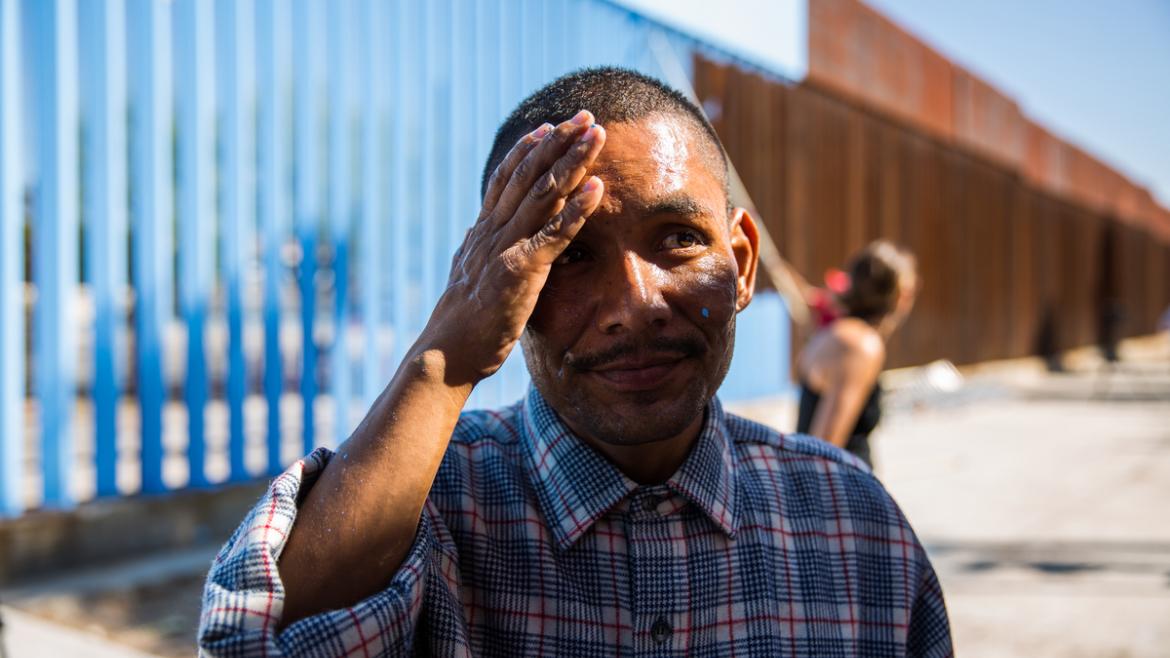An artist's dream: Making the border appear to disappear

Manuel Flores Flores teeters on a 15-foot ladder propped up against the south side of the U.S.-Mexico border wall that cuts through the city of Nogales.
To some, it might look like Flores Flores is trying to cross. Rather, the Mexican national has a paintbrush in hand, coating the fence’s rusty red posts with a calming hue of sky blue.
His work is part of Ana Teresa Fernandez’s community art project aimed at making the border, one of the region’s most contested constructs, appear to disappear against the sky.

Luis Antonio Esguerra wipes paint off of his face.
And it seems to be working.
“I know it’s just blue and it’s just covering the fence, but it makes it look like it’s just open and that’s kind of cool,” said Mary Ochoa, a resident of Nogales, Arizona.
The mural project began Monday as part of Fernandez’s time as artist-in-residence with Arizona State University’s Performance in the Borderlands program, which posits the borderland as a conceptual landscape that embodies political and identity borders. The painted section will remain colored, with the plan to do it again next year.
Fernandez has always recognized the influence of how the 1,954 miles of U.S.-Mexico border plays into her work.
She grew up in Tampico, Tamaulipas, Mexico, until age 10, when she crossed the border into the U.S. Fernandez credits her cross-cultural upbringing for the ability to recognize that shifting one’s experience and perspective can create a new understanding of an object or practice.
“When you realize that visual art can translate beyond languages, beyond races, beyond social class it just becomes the most expansive medium of communication and I think that it’s contagious ... ,” the artist said during one of the many interviews conducted by a steady stream of media, curious to see what Fernandez and the various volunteers and passerbys would do to the border.
Most of the work was simply coloring the wall — with paint rollers attached to extension arms or brushes used to fill the crevices where the square beams meet the metal plate that is mounted above them.
A group of ASU students chose to attend the event alongside Fernandez, but many Nogales residents, like Alejandro Ramirez Mendoza whose arms and red shirt were soon covered in spatterings of blue, simply saw the activity and felt the desire to join in.
“It’s better, it’s more presentable,” Mendoza said, reflecting on the work.
He then returned to his roller and resumed painting as a passing motorcyclist rubbernecked at the wall and a well-dressed woman in a black dress and carrying a box of pastries stopped to watch.
Ochoa and Phillip Woods were on their way to the north side of the border when they walked by the artist’s work. They paused their trip to join the project, high-fiving some of the student helpers while covering a section of the fence in paint.
The process caused Ochoa to reflect on the sights and memories associated with the divisive wall.
“It’s very sad watching families hold hands through here, that’s as far as they go, they can’t even really hug,” she said. “They touch each other’s hands, ‘Hey I miss you and I love you,’ and it’s really sad to see.”
Those are the exchanges, shared between the bars of the imposing wall, that Fernandez sees as a base for a project like “Erasing the Border.”
“I think a huge part of what I’m hoping would happen is that echoing, that reverberation of it, of the piece not just stopping here in the making of it, but hopefully the conversations that will be ignited about it,” Fernandez said.
This border project, which was coordinated with U.S. and Mexican border patrols, is the continuation of the artist’s piece “Borrando la Frontera,” or “Erasing the Border.” In 2012 Fernandez, dressed in a classic black cocktail dress, visited the U.S.-Mexico border fence at the beach in Tijuana and painted it the same hazy color of the ocean sky.
From a distance the otherwise jarringly black fence dissolved into a natural part of the seaside landscape it divides.
Nogales has provided Ferandez with a different approach in Nogales.
“One was a much more conceptual artistic rendering of this piece, but this one is a much more community-based piece so there are all hands on this particular project that are literally erasing the border together,” says Mary Stephens, director of ASU’s Performance in the Borderlands.
“I think that that has offered a new way for us to engage this project as well, how can we as a community erase borders.”
Performance in the Borderlands, an initiative through the Herberger’s School of Film, Dance and Theatre, has sponsored Fernandez’s statewide residency. This includes public talks, community workshops and dialogues, professional development training and a public art project based in Nogales, Sonora.
Fernandez’s residency with Performance in the Borderlands, which is an initiative through the Herberger Institute’s School of Film, Dance and Theater, has taken the artist to lectures in Flagstaff, Douglas, Nogales and Phoenix, where she has spoken about how her work deals with themes of feminism, border politics and arts production.
“It’s been incredibly amazing, I never expected to be able to touch and communicate with so many sectors of the community,” Fernandez said. “It was so expansive and it just felt continuously like an intellectual and creative labyrinth where the conversations were constant.”
By Deanna Dent
ASU News

